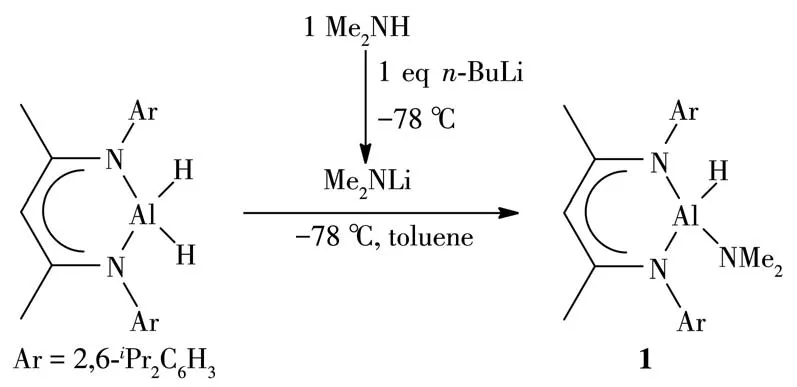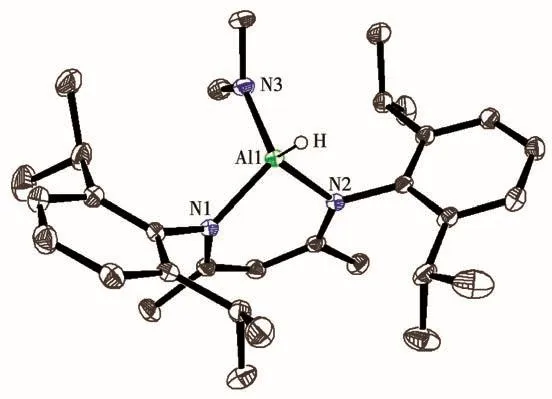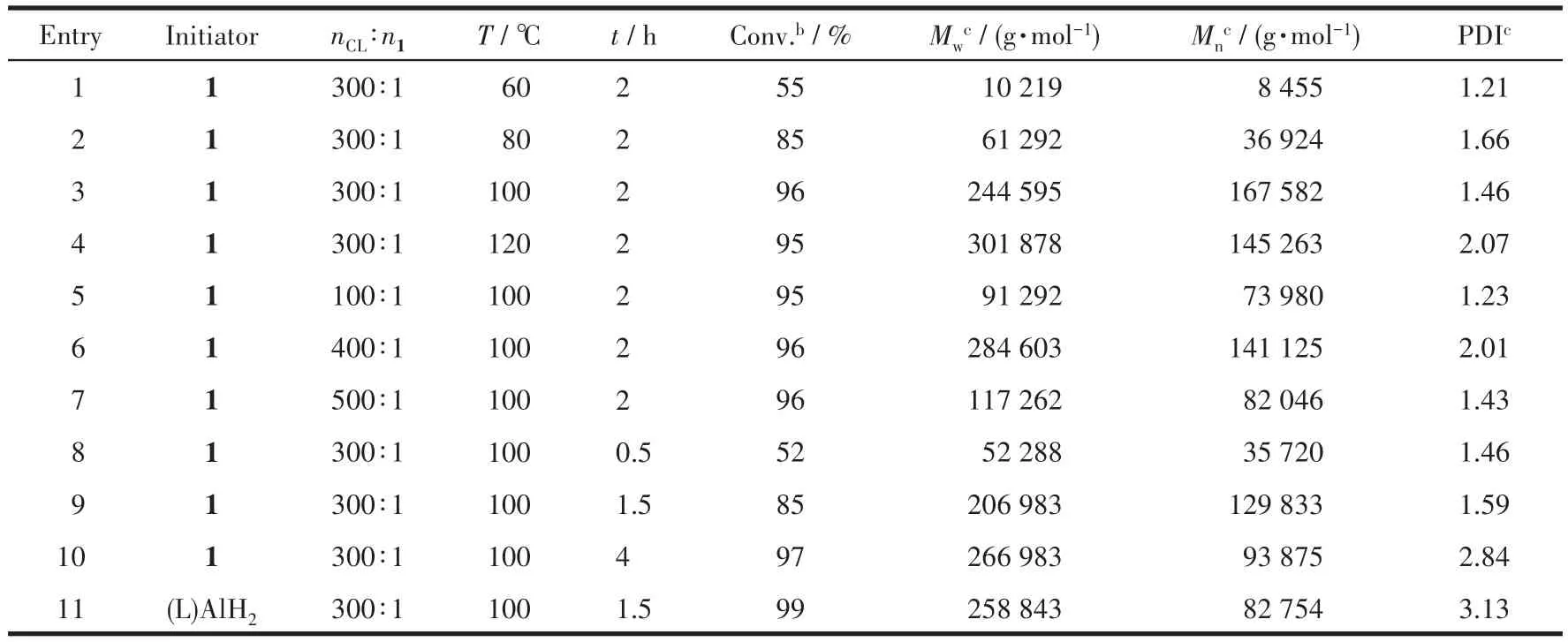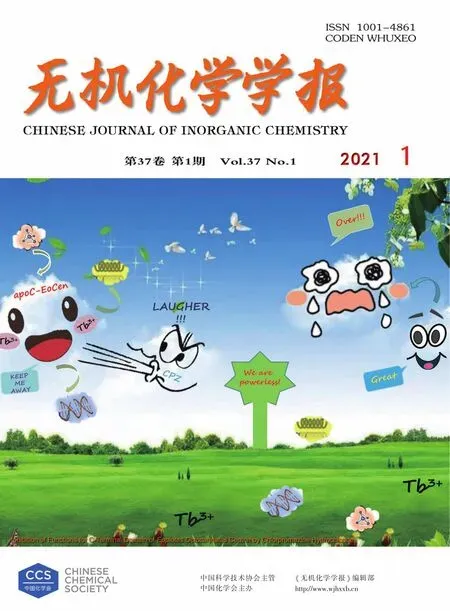Aluminum Amine Compound Protected by β-Diketiminate Ligand:Preparation and Enhanced Performance as Catalyst for Ring-Opening Polymerization of ε-Caprolactone
2021-02-24LIWenLingYANBenSUNChenGuangSHENQiuMiaoLIUWenQingMAXiaoLiYANGZhi
LI Wen-LingYAN BenSUN Chen-GuangSHEN Qiu-Miao LIU Wen-Qing MA Xiao-Li*,YANG Zhi*,
(1School of Chemistry and Chemical Engineering,Beijing Institute of Technology,Beijing 102488,China)
(2The Key Laboratory of Advanced Materials of Ministry of Education,School of Materials Science and Engineering,Tsinghua University,Beijing 100084,China)
Abstract:An aluminum amine compound(L)AlH(NMe2)(L=HC(C(Me)NAr)2,Ar=2,6-iPr2C6H3)(1)protected by steric β-diketiminate ligand L has been synthesized successfully.A two-step synthesis method was employed to prepare the aluminum amine(L)AlH(NMe2)compound.The aluminum amine compound(L)AlH(NMe2)was identified viaNMR spectroscopy,elemental analysis,infrared diffuse reflectance spectroscopy and X-ray single crystal diffraction analysis.The aluminum amine compound containing both Al-NMe2and Al-H substitutes showed excellent catalytic performance on the ring-opening polymerization of ε-caprolactone.The molecular weight and molecular weight distribution of the resultant polycaprolactone were determined by high performance gel penetration chromatography.CCDC:1542786.
Keywords:β-diketiminate ligand;aluminum amine compound;X-ray single crystal diffraction;ring-opening polymerization
The amount of plastic waste has been increasing drastically over the past decades which caused serious environmental pollution and ecological disaster.Waste plastic is usually disposed of by incineration or landfill and the treatment of plastic pollution has become a common consensus of the international community.Therefore,there is an urgent need to find environmentally friendly,reasonably priced plastics and related alternative products[1].Aliphatic polyester,polycarbonate and polylactic acid have attracted much attention in recent years due to their good biocompatibility and biodegradability.Forexample,poly(ε-caprolactone)(PCL)and poly lactide(PLA)are widely used in pharmaceutical and plastics fields due to their good permeability[2-3].Ring-opening polymerization (ROP) of cycloesters is considered as one of the most promising methods for preparing polyester materials.Different from traditional polycondensation catalytic reactions,the ROP has great advantages in controlling molecular weight and molecular weight distribution of the polymers[4].
Metal-organic compounds can efficiently initiate the ROP of cycloesters.The design and synthesis of metal-organic catalysts with appropriate substitutes become an important research direction for the preparation of polyester materials[5].The metal center acts as a Lewis acid to increase the positive charge of carbonyl groups of cyclic esters molecule to initiate the ROP.Previous studies showed that metal organic compounds containing different metal centers,such as Zn[6-7],Ca[8],Mg[9-10],Ti[11-12],Sn[13-15]and Yb[16],exhibited high performance on the ROP of lactones(or lactide).However,the trace metals are often present in the polymer products and difficult to remove completely.Organoaluminum compounds have attracted much attention due to their low toxicity,easy preparation and low cost[17-18].In the past decades,many kinds of aluminum alkoxides or alkyl complexes protected with different ligands,including salen,enolic salen,Schiff base,ketiminate,amidinate,and aminophenolate ligands,have been synthesized and used as catalysts in the ROP reactions[19-24].And most of the polymer molecular weight are lower than 105g·mol-1.According to the results of Huang[25-28],Wang[29-32],Ma[33-37]and our group[38-39],the steric effect and electronic properties of metal-organic compounds played dominant roles in their catalytic activities for the ROP of ε-caprolactone.Further studies indicated that proper Lewis acidity of the aluminum center could improve the catalytic performance.Thus,many efforts have been devoted to the steric ligand design of the aluminum alkoxides or alkyl complexes to increase the catalyst activity,and the effect of the substituents at the metal center is usually ignored.
In the past twenty years,β-diketimines were employed as ideal ligands to protect mental centers,and numbers of multifunctional aluminum derivatives were synthesized successfully owing to its steric feature and flexible electric properties.So,we synthesized the organoaluminum hydrogen compound supported byβdiketiminate ligand with-NMe2substitute at the Al center.The catalytic properties of the resultant organoaluminum hydrogen compound for the ROP ofε-caprolactone were studied in detail.
1 Experimental
1.1 General procedures
All the preparations were carried out under dry N2atmosphere using glovebox techniques and standard Schlenk lines.The related solvents such as toluene,THF and hexane were treated at least 6 h under Na/K alloy before distillation to use.Deuterated solvent CDCl3was purified over CaH2for 24 h and distilled under reduced pressure.ε-caprolactone was dried by 4A molecular sieves.1H NMR spectra was recorded on Bruker Avance 400 MHz spectrometer.The melting point of compound 1 was measured in sealed capillaries using XT4A melting point apparatus.Elemental analysis was carried out using Vario ELⅢanalyser in the Analytical Instrumentation Center of the Tsinghua University.The IR spectra were recorded using Nicolet 6700 spectrometer from 4 000 to 650 cm-1.Gel penetration chromatography(GPC)measurements were performed by Shimadzu CTO-20A system equipped with polystyrene gel columns using THF(HPLC grade)as an eluent(flow rate:1.0 mL·min-1,25 ℃).(L)AlH2was synthesized as described previously[38].
1.2 Synthesis of(L)AlH(NMe2)
n-BuLi(1 mmol,0.4 mL)was mixed with one equivalent of HNMe2(1 mmol,2 mL)in toluene at-78℃,and the mixture was allowed to warm up to room temperature and kept on stirring for 12 h to generate LiNMe2.The above mixture was transferred to the flask with(L)AlH2(1 mmol,0.446 g)in toluene at-78℃.The reaction temperature was kept at-78℃for 1 h,then the mixture was allowed to warm up to room temperature and stirred for 24 h.All the solvents were removed under vacuum,and the residue was extracted withn-hexane.Colorless crystals of compound 1 suitable for X-ray diffraction analysis were produced from a concentrated solution at 0℃after three days(0.392 g,85%).m.p.170 ℃.IR(KBr,cm-1):1 873 cm-1(m,Al-H).Elemental analysis Calcd.for C31H48AlN3(%):C 76.03,H 9.88,N 8.58;Found(%):C 75.36,H 9.72,N 8.32.1H NMR(400 MHz,CDCl3,298K):δ7.20~7.11(m,6 H,Ar—H),5.13(s,1 H,γ-H),3.25(m,4 H,CH(CH3)2),1.73(s,6 H,C(CH3)),1.26(d,12 H,CH(CH3)2),1.13(d,12 H,CH(CH3)2).
1.3 X-ray single crystal diffraction study
Single-crystal diffraction analysis was conducted by Bruker APEXⅡDUO instrument under low temperature by utilizing graphite monochromated MoKα(λ=0.071 073 nm)as the incident light source.The data were integrated and corrected by SAINT[40].Semiempirical absorption corrections were applied with SADABS program[41].The crystal structure was directly resolved by SHELXL and OLEX 2[42-43],all nonhydrogen atoms were refined by full-matrix leastsquares refinement based onF2,hydrogen atoms connected to carbon and aluminum atoms were included at geometrically calculated positions and refined by using a riding model.The crystal and structure refinement parameters for compound 1 are shown in Table 1.
CCDC:1542786.

Table 1 Crystal and structure refinement parameters for compound 1
1.4 ROP of ε-caprolactone catalyzed by compound 1
Typically,the initiator 1(0.023 g,0.05 mmol)andε-caprolactone(3.42 g,30 mmol)were dissolved in toluene(30 mL)in separate flasks.Then the monomer solution was transfered to the initiator flask at 100℃and kept stirring for 2 h.The reaction was terminated with acetic acid(1 mL).All solvents were removed under vacuum,and the residue was dissolved with THF(30 mL).The white solid appeared immediately afternhexane(20 mL)was added.White polymer solid was obtained in high yield(95%)after filtration,washing with hexane and removal of volatiles.
2 Results and discussion
2.1 Description of compound 1
The synthesis of aluminum amine compound 1 is shown in Scheme 1.Reaction ofn-BuLi with one equivalent of HNMe2in toluene at-78℃generated LiNMe2.It is worth noting that the ratio control is crucial for this reaction.The lithium was transferred to the flash with one equivalent of HNMe2in toluene at-78℃and kept for 0.5 h.Then the mixture was allowed to warm up to room temperature and kept stirring for 12 h.Compound 1 was obtained in 85% yield.Compound 1 was characterized by1H NMR.The spectrum showed a new resonance atδ=2.38,and the ratio to theγ-H proton(CCHC)was 6∶1,which confirmed the formation of desired AlH(NMe2)framework.The resonance for the Al-H could not be observed in the1H NMR because of the quadrupolar broadening by the Al nucleus.The presence of Al—H bonds in 1 was evident from the IR spectra.The broad IR bands around 1 873 cm-1is owing to the Al—H stretching frequency,which matches well with the value of 1 860 cm-1reported[44].

Scheme 1 Synthesis of compound 1
Compound 1 suitable for X-ray crystal diffraction crystallizes in the triclinic space groupP1(Fig.1).The structure was determined by X-ray single crystal diffraction.The aluminum atom is stabilized by—NMe2and—H substituents.The sum of angles around the Al center is 317.87°,which exhibits a distorted tetrahedral geometry.The Al—N bond distances(Al1—N1 0.191 9(2)nm,Al1—N2 0.191 4(2)nm)agree well with the relative coordinated bond distances(0.190 1(3)~0.199 6(4)nm)reported in previous studies[29-31].The bond distance of Al1—N3(0.180 0(2)nm)is much shorter than the coordinated Al—N distance,which is in good agreement with the single bond nature.

Fig.1 Molecular structure of 1
2.2 Catalytic performance on the ROP of εcaprolactone
Many organoaluminum compounds were evaluated as initiators of the ROP ofε-caprolactone.Huang et al.reported that aluminum hydrides were catalytically active in the ROP ofε-caprolactone[45].However,compared with those aluminum monohydrides,the polydispersity index(PDI)values of PCL initiated by aluminum dihydride were relatively broad because of the side reactions or multiple reacting sites(Al—H or Al—N).Besides,the catalytic performance of aluminum alkoxides or alkyl protected byβ-diketiminate ligand were studied systematically by many groups.Generally,the polymer molecular weight is mostly in a range of 103~105g·mol-1[36-39].The steric effect was proposed as the main factor for the polymerization activity.
The catalytic activity of compound 1 to the ROP ofε-caprolactone was studied systematically(Table 2).According to the catalytic results,the conversion of monomer increased with the increasing polymerization temperature.Meanwhile,the PDI(PDI=Mw/Mn)values of PCL also ranged from 1.21 to 2.07.(Entry 1~4 in Table 2).The molecular weight and PDI was also influenced by the ratio of the monomer to initiator(Entry 3,5~7 in Table 2)and the reaction time(Entry 3,8~10 in Table 2).Organoaluminum compound 1 containing—NMe2and—H substituents at the atom center showed excellent catalytic activity in the ROP of ε-caprolactone.Besides,we also evaluated the catalytic performance of starting material((L)AlH2).Similarly,the PDI values of PCL were relatively broad as the results reported by Huang's group[45].We estimated that the excellent catalytic activity of 1 might be attributed to the proper Lewis acid property of the Al center,which allowed the carbonyl to coordinate with the metal center and initiated the ROP reactions.

Scheme 2 ROP of ε-caprolactone catalyzed by compound 1

Table 2 ROP of ε-caprolactone(CL)catalyzed by aluminum amine compounda
3 Conclusions
In summary,aluminum amine compound supported byβ-diketiminate ligand was synthesized successfully via salt elimination reaction.The lithium LiNMe2was synthesized using HNMe2andn-BuLi as precursors,and the reactant ratio and reaction temperature were strict for the formation of the aluminum amine compound.Compound 1 containing Al—NMe2and Al—H groups is an excellent initiator for the ROP ofε-caprolactone.Proper Lewis acid of 1 exerts important effect on the polymerization ofε-caprolactone.The above findings would enable the rational design of aluminum amine compound with proper substituents at the metal center to prepare polymer with high molecular weight and narrow molecular weight distribution.
杂志排行
无机化学学报的其它文章
- 《无机化学学报》投稿须知(NOTICE TO AUTHORS)
- 三维α-MnO2@Co3O4异质材料的制备、表征及其催化性能
- Preparation,Structures and Thermal Stabilities of Four Transition Metal Complexes Constructed by 3,7-Di(3-pyridyl)-1,5-dioxa-3,7-diazacyclooctane Bipyridine Ligand
- 基于1D/0D有序复合SnO2纳米晶的钙钛矿太阳能电池
- 三元混配铜(Ⅱ)配合物的晶体结构、DNA作用及其生物活性
- 巯基/羧基修饰硅藻土及其对Pb(Ⅱ)、Cd(Ⅱ)的吸附性能
